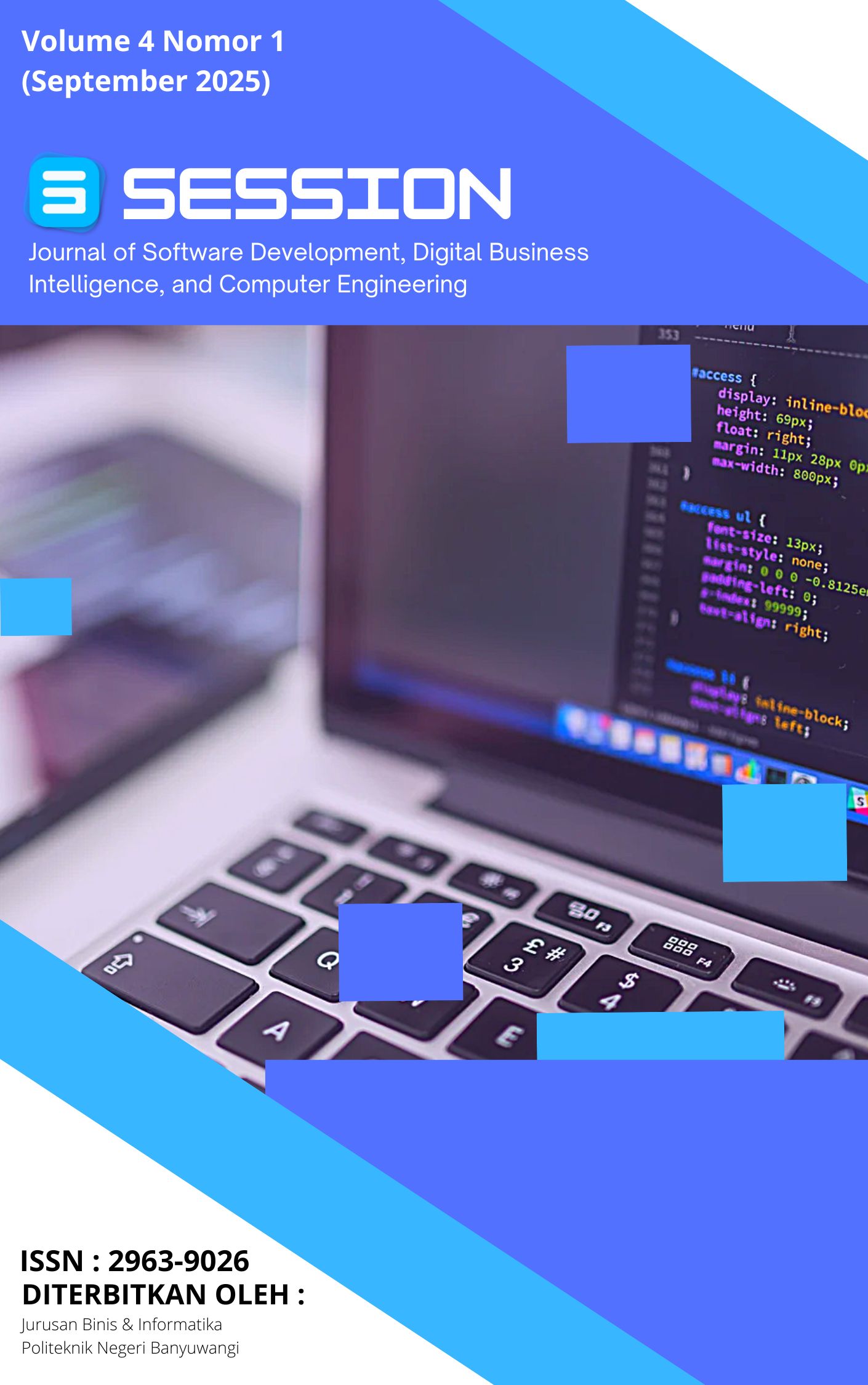Metode Personal Extreme Programming pada Pengembangan Sistem Rekam Medis Elektronik Klinik Gigi
DOI:
https://doi.org/10.57203/session.v4i01.2025.36-43Keywords:
Electronic Medical Records, Dental Clinics, Personal Extreme ProgrammingAbstract
Resource limitations, costs, time estimates and changing requirements are some of the importat factors that must be considered in the small-sclae software development stage. This research aims to develop a web-based Medical Records System (MRS) to accelerate the registration and storage of patient medical records. The software development method used is Personal Extreme Programming (PXP), which assists individual developers in building systems that are responsive to changing user needs. The PXP stages include requirements and planning, iteration initialization, design, implementation, system testing, and a retrospective. The requirement planning stage is represented by 8 user stories. There are 4 iterations in the development process with an estimated development time of 38 days. The system was designed using wireframe, implemented using the Laravel framework, and tested using Unit Testing and User Acceptance Testing (UAT). Test results showed that the system was well received by 10 users, with average UAT scores of Very Good for patients, doctors and clinic administrator. The system development time was 8 days faster because the PXP method minimized system development documentation. So, it can be concluded that the PXP method can be a solution for individual developers in developing small-scale clinical systems.
References
[1] Dinas Kesehatan Kabupaten Banyuwangi. (2022). Profil Kesehatan Kabupaten Banyuwangi Tahun 2021. https://dinkes.banyuwangikab.go.id/portal/profil-kesehatan-dinkes/
[2] Prasetyo, M. Z., Susanto, E. R., Wantoro, A., Penulis, N., Zihad, M., & Submited, P. (2023). SISTEM INFORMASI REKAM MEDIS PASIEN THALASSEMIA (STUDI KASUS : POPTI Cabang BANDAR LAMPUNG). Jurnal Teknologi Dan Sistem Informasi, 4(3), 349–355. https://doi.org/10.33365/jtsi
[3] Kementerian Kesehatan Republik Indonesia. (2022). PERATURAN MENTERI KESEHATAN REPUBLIK INDONESIA NOMOR 24 TAHUN 2022 TENTANG REKAM MEDIS. https://peraturan.bpk.go.id/Details/245544/permenkes-no-24-tahun-2022
[4] Jepisah, D., Sari, P., Octaria, H., Mentari, W., Husna, A., & Pekanbaru, H. T. (2022). The Role of Electronic Medical Records (RME) on Hospital Management Information Systems at Regional General Hospitals in Riau Province in 2021 Peranan Rekam Medis Elektronik (RME) Terhadap Sistem Informasi Manajemen Rumah Sakit Di Rumah Sakit Umum Daerah Provinsi Riau Tahun 2021. In Community Engagement & Emergence Journal (Vol. 3). https://journal.yrpipku.com/index.php/ceej
[5] Cahyani, M. B., Syafanny, L. D. A., Kamil, S. S. A., Mukharama, K. A., & Sutha, D. W. (2024). Tinjauan Literatur: Peran Rekam Medis Berbasis Elektronik Terhadap Pelayanan Kesehatan. Jurnal Manajemen Informasi Kesehatan Indonesia, 12(2).
[6] Yossiant, S., & Hosizah, H. (2023). Implementasi Rekam Medis Elektronik di Klinik Kidz Dental Care. Indonesian of Health Information Management Journal (INOHIM), 11(1), 50–55. https://doi.org/10.47007/inohim.v11i1.498
[7] Aryani Susanti, F., & Ariati, S. (2024). Analysis of Workload of Medical Records Officers: Switching from Manual Medical Records to Electronic Medical Records in X Hospital in 2024. Jurnal Manajemen Informasi Dan Administrasi Kesehatan, 7(2), 196–201. https://doi.org/10.32585/jmiak.v7i2.5432
[8] Anggriani, M., Syahidin, Y., Sari, I., & Sukmawijaya, J. (2023). Desain Tata Kelola Rekam Medis Elektronik Berbasis Teknologi Informasi Dalam Pelayanan Pasien IGD Dengan Metode Agile. Jurnal Teknologi Sistem Informasi Dan Aplikasi, 6(3), 248–255. https://doi.org/10.32493/jtsi.v6i3.29815
[9] Lahama, cindy, Montolalu, C. E. J. C., & Tenda, E. (2024). Web-Based Pharmacy Information System Using Personal Extreme Programming (PXP) Method with MVC Architecture. Indonesian Journal of Intelligence Data Science, 3(1), 61–72. https://doi.org/10.35799/ijids.v3i1.50142
[10] Bagus Gede Sarasvananda, I., & Komang Arya Ganda Wiguna, I. (2021). Pendekatan Metode Extreme Programming untuk Pengembangan Sistem Informasi Manajemen Surat Menyurat pada LPIK STIKI. Jurnal Informatika Universitas Pamulang, 6(2), 258–267. https://doi.org/10.32493/informatika.v6i2.9482
[11] G. E. Iyawa, “Personal Extreme Programming: Exploring Developers’ Adoption Completed Research,” Americas Conference on Information Systems , pp. 1–10, 2020, [Online]. Available: http://shura.shu.ac.uk/27536/
[12] Fikri, A. M., & Arthawan, I. P. D. (2020). Rancang Bangun Sistem Informasi Buku Tamu pada Dinas Pemuda, Olahraga dan Pariwisata Kota Balikpapan dengan Metode Personal Extreme Programming. Multitek Indonesia: Jurnal Ilmiah, 14(2), 1907–6223. http://journal.umpo.ac.id/index.php/multitek
[13] H. I. Hasan, G. I. Marthasari, and I. Nuryasin, “Implementasi Metode Personal Extreme Programming Dalam Pengembangan Sistem Administrasi Pelayanan Desa (Studi Kasus: Desa Bulangan Barat Kec. Pegantenan Kab. Pamekasan)”, JR, vol. 3, no. 1, Jan. 2024.
[14] Fahrijal, Taufik; Hartawan, Rumadi. Analisis Perbandingan Extreme Programming dengan Personal Extreme Programming Pada Impelementasi Software. Jurnal Manajamen Informatika Jayakarta, [S.l.], v. 4, n. 4, p. 367-382, sep. 2024. ISSN 2797-0930.
[15] Melinda, V., & Zein, A. (2023). Perancangan Sistem Informasi Tour dan Travel Berbasis Web Menggunakan Metode Personal Extreme Programming (PXP) pada Today Trip. Jurnal Ilmu Komputer, 6(1).
Downloads
Published
Issue
Section
License
Copyright (c) 2025 Dianni Yusuf, Farizqi Panduardi, Mohammad Rashel Arrizki, Sepyan Purnama Kristanto, Agus Priyo Utomo

This work is licensed under a Creative Commons Attribution 4.0 International License.
Copyright :
Authors who publish their manuscripts in this journal agree to the following conditions.
- The copyright on each article belongs to the author(s).
- The author acknowledges that Jurnal SESSION: Software Development, Digital Business Intelligence, and Computer Engineering has the right to be the first to publish with a Creative Commons Attribution 4.0 International license (Attribution 4.0 International (CC BY 4.0).
- Authors can submit articles separately, arrange for the nonexclusive distribution of manuscripts that have been published in this journal into other versions (e.g., sent to the author's institutional repository, publication into books, etc.), by acknowledging that the manuscript has been published for the first time in the Jurnal SESSION: Software Development, Digital Business Intelligence, and Computer Engineering.
License:
![]()
Jurnal SESSION: Software Development, Digital Business Intelligence, and Computer Engineering is licensed under a Creative Commons Attribution 4.0 International License.
This license permits anyone to copy and redistribute this material in any form or format, compose, modify, and make derivatives of this material for any purpose, including commercial purposes, as long as the author credits the original work.








